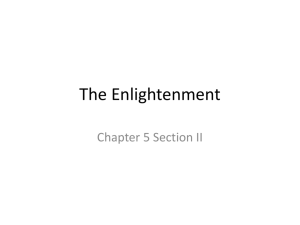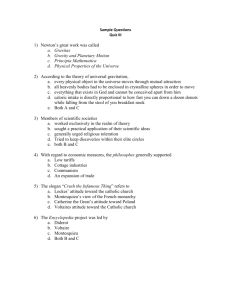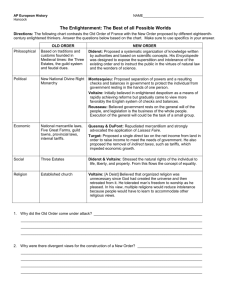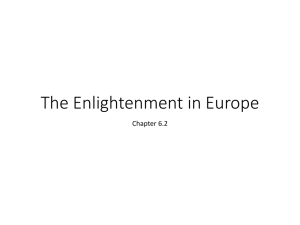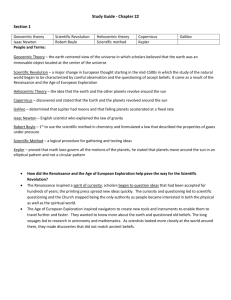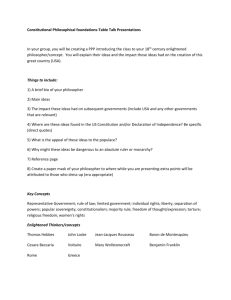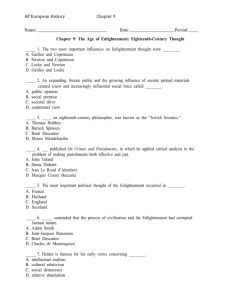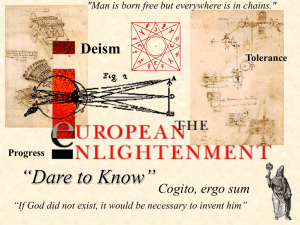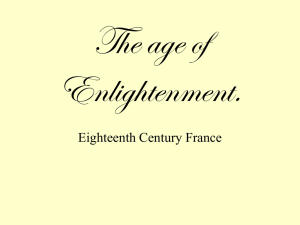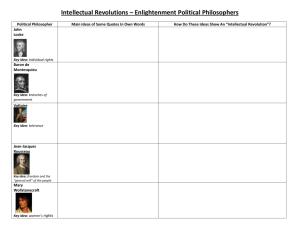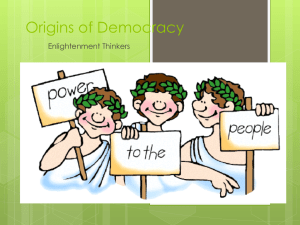Test # ______ CHAPTER 9 UNIT EXAM: ANSWER KEY THE AGE
advertisement
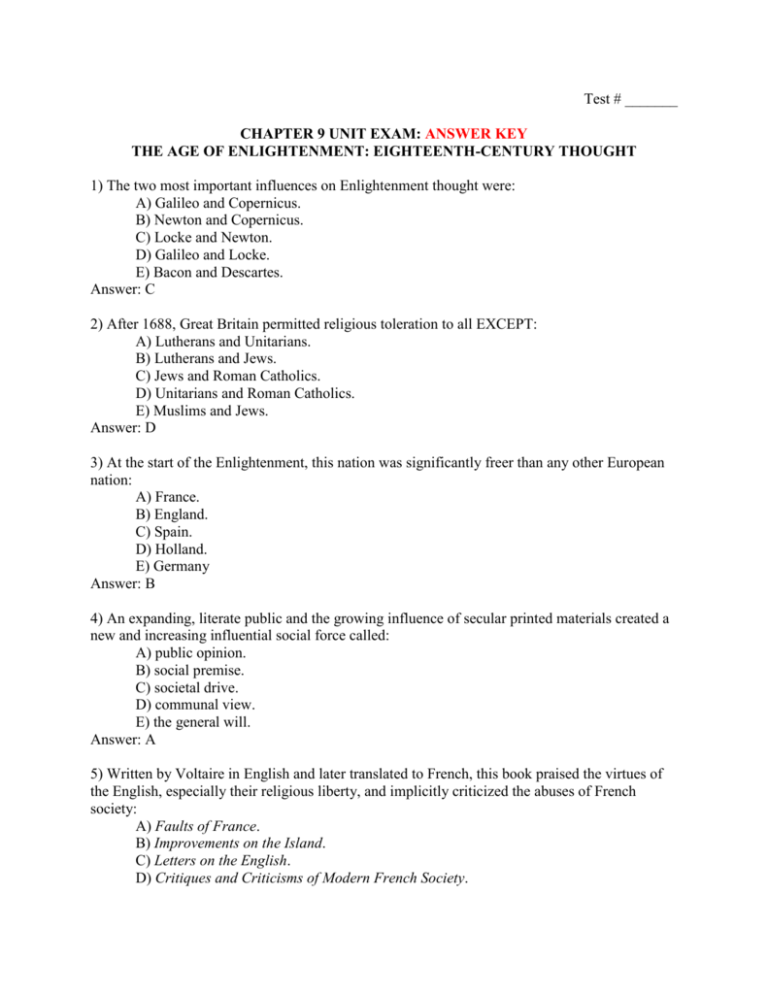
Test # _______ CHAPTER 9 UNIT EXAM: ANSWER KEY THE AGE OF ENLIGHTENMENT: EIGHTEENTH-CENTURY THOUGHT 1) The two most important influences on Enlightenment thought were: A) Galileo and Copernicus. B) Newton and Copernicus. C) Locke and Newton. D) Galileo and Locke. E) Bacon and Descartes. Answer: C 2) After 1688, Great Britain permitted religious toleration to all EXCEPT: A) Lutherans and Unitarians. B) Lutherans and Jews. C) Jews and Roman Catholics. D) Unitarians and Roman Catholics. E) Muslims and Jews. Answer: D 3) At the start of the Enlightenment, this nation was significantly freer than any other European nation: A) France. B) England. C) Spain. D) Holland. E) Germany Answer: B 4) An expanding, literate public and the growing influence of secular printed materials created a new and increasing influential social force called: A) public opinion. B) social premise. C) societal drive. D) communal view. E) the general will. Answer: A 5) Written by Voltaire in English and later translated to French, this book praised the virtues of the English, especially their religious liberty, and implicitly criticized the abuses of French society: A) Faults of France. B) Improvements on the Island. C) Letters on the English. D) Critiques and Criticisms of Modern French Society. E) The Spirit of the Law. Answer: C 6) Which philosophe wrote the comedy Candide, which criticized and attacked war, religious persecution, and unwarranted optimism about the human condition? A) Montesquieu B) Voltaire C) Rousseau D) Diderot E) Wollstonecraft Answer: B 7) Philosophes criticized the Christian church for all of the following EXCEPT: A) teaching about human reason. B) encouraging more concern with the afterlife than with life on earth. C) teaching intolerance. D) inciting wars. E) taking too limited a role in national politics. Answer: E 8) The two major points in the Deists' creed were: A) an afterlife dependent upon the existence of a rational God and on one's earthly actions. B) the belief in the existence of a rational God and the existence of absolute principles. C) the belief in an afterlife dependent upon one's earthly actions and the existence of absolute principles. D) the belief in the existence of absolute principles and the illogical nature of God's existence. E) the belief that God had not created human beings and that humans did not have a soul. Answer: A 9) Which of the following philosophes came closest to atheism in their religious thinking? A) Lessing B) Toland C) Locke D) Voltaire E) Baron d'Holbach Answer: E 10) According to Ethics, the most famous of his works, this man closely identified God and nature, an idea for which his contemporaries condemned him: A) Hobbes. B) Spinoza. C) Descartes. D) Mendelsohn. E) Locke. Answer: B 11) This 18th century philosopher was known as the "Jewish Socrates": A) Hobbes. B) Spinoza. C) Descartes. D) Mendelsohn. E) Lessing. Answer: D 12) The Encyclopedia: A) secularized learning and spread Enlightenment ideas throughout Europe. B) sold about 1,200 copies. C) received official support. D) was written entirely by Denis Diderot and Jean Le Rond d'Alembert. E) was written in 1750, but not published until 1789. Answer: A 13) He published On Crimes and Punishments, in which he applied critical analysis to the problem of making punishments both effective and just: A) John Toland. B) Denis Diderot. C) Jean Le Rond d'Alembert. D) Marquis Cesare Beccaria. E) Montaigne. Answer: D 14) Adam Smith advocated: A) a large role for government in the economy. B) the ending of England's mercantile system. C) the elimination of England's navy and army. D) that government take zero part in the economy. E) an end to all taxes. Answer: B 15) According to Smith, government should provide: A) armies, navies, roads, and hospitals. B) hospitals, armies, navies, and schools. C) armies, navies, roads, and parks. D) schools, armies, navies and roads. E) armies, navies, markets, and banks. Answer: D 16) According to Smith's four-stage theory, human societies: A) have no real moral basis. B) can be religious, secular, scientific, or superstitious. C) need four social groups to succeed. D) cannot evolve under a monarchy. E) move from barbarism to civilization. Answer: E 17) The ________, particularly of France, believed mercantilist legislation and the regulation of labor by governments and guilds actually hampered the expansion of trade, manufacture, and agriculture. A) bourgeoisie B) physiocrats C) philosophes D) enlightened absoutists E) tradesmen Answer: B 18) In his theory of laissez-faire economics, Adam Smith maintained that A) workers’ real wages decrease in the long run. B) population always tends to outstrip food supply. C) monopolies benefit the state. D) competition is socially beneficial. E) social revolution is inevitable. Answer: D 19) In laissez-faire economic theory, what/who should control the economy? A) The monarchy B) The Church C) The peasants D) The law of supply and demand E) God’s will Answer: D 20) The most important political thought of the Enlightenment occurred in: A) France. B) Holland. C) Russia. D) England. E) Scotland. Answer: A 21) He contended that the process of civilization and the Enlightenment had corrupted human nature: A) Smith. B) Rousseau. C) Descartes. D) Montesquieu. E) Voltaire. Answer: B 22) Most European thinkers associated with the Enlightenment: A) favored social revolution. B) were members of the artisan class. C) were proponents of democracy. D) were atheists. E) favored monarchies and the expansion of European empires. Answer: E 23) One of Montesquieu's most far-reaching ideas was the A) separation of powers in government. B) separation of church and state. C) adaptation of an atheist constitution. D) abolition of torture as a punishment and crime deterrent. E) equal voting rights for women. Answer: A 24) Rousseau blamed much of the evil in the world on A) the Church. B) women. C) unequal distribution of wealth. D) monarchies. E) human nature. Answer: C 25) Radical reformer ________ envisioned a society in which each person could maintain personal freedom while behaving as a loyal member of the larger community. A) Voltaire B) Rousseau C) Diderot D) Wollstonecraft E) Montesquieu Answer: B 26) Which statement best summarizes Diderot’s opinions about European government’s methods and aspirations in expanding their empires around the world? A) Diderot believed Europeans had a moral duty to spread their culture to inferior people. B) Diderot believed slavery was a necessary evil in the spread of empire and acquisition of wealth. C) Diderot condemned European governments and accused them of tyranny and religious hypocrisy. D) Diderot did not believe Europeans were acquiring wealth quickly enough. E) Diderot wanted to bring Christianity and modern technology to the people of Africa and Asia. Answer: C 27) Though there were some exceptions, the philosophes generally: A) advocated fundamental changes in the social condition of women. B) believed women to be socially equal but not politically equal to men. C) said little about women. D) were not avid feminists. E) saw women as the intellectual equals of men. Answer: D 28) He maintained that women were not naturally inferior to men and that women should have a wider role in society. He was also sympathetic in his observations concerning the value placed on women's appearance and the prejudice women met as they aged: A) Smith. B) Rousseau. C) Descartes. D) Montesquieu. E) Voltaire. Answer: D 29) According to Rousseau, what type of education should women receive? A) One in which they can participate in public and civic life as equals to men. B) One in which they are taught to be good mothers, but also given education and opportunity to participate in public and civic life. C) One which teaches women only to be pleasing to men and be good, loving mothers to their children. D) One which encourages women to expand their economic roles in the family and society. E) One which encourages women to think for themselves and liberate themselves from man-made inequality. Answer: C 30) Mary Wollstonecraft’s response to Rousseau in her work A Vindication of the Rights of Woman (1792) argues that A) women should receive an education equal to men so that women can learn to be virtuous and independent. B) women should have a hired worker to help raise the children so they can focus more on their own education and career. C) giving women an education makes them more moral, intelligent, and strong, which in turn makes them better mothers and wives. D) all of the above. E) A and C only. Answer: E 31) Which of the following styles of art utilizes lavish, often lighthearted decoration with an emphasis on pastel colors and the play of light? A) classical B) abstract C) impressionism D) neoclassicism E) rococo Answer: E 32) Which of the following styles of art embodies a return to figurative and architectural modes drawn from the Renaissance and the ancient world? A) rococo B) abstract C) impressionism D) neoclassicism E) expressionism Answer: D 33) Neoclassical paintings were didactic (educational) rather than emotional and their subject matter usually concerned: A) public life or public morals. B) intimate family life. C) daily routines. D) leisure activities. E) nature. Answer: A 34) The popularity of the city of ________ as a destination for artists and aristocratic tourists contributed to the rise of neoclassicism. A) Paris B) London C) Prague D) Rome E) Constantinople Answer: D 35) He was a strong monarchist who in 1759 published a History of the Russian Empire under Peter the Great, which declared, "Peter was born, and Russia was formed": A) Diderot. B) Rousseau. C) Descartes. D) Montesquieu. E) Voltaire. Answer: E 36) Enlightened monarchs of the eighteenth century supported all of the following EXCEPT A) religious tolerance B) increased economic productivity C) pacifist (peaceful) foreign policy D) administrative reform E) secular and technical education Answer: C 37) Monarchs such as Joseph II and Catherine II made "enlightened" reforms as part of their drive to: A) increase revenues and gain political support. B) begin the process of moving away from monarchy. C) begin the process of moving toward constitutional monarchy. D) give commoners more political power. E) do away with the nobility in their realms. Answer: A 38) This monarch embodies enlightened absolutism more than any other. He/she forged a state that commanded the loyalty of the military, the junker nobility, the Lutheran clergy, and a growing bureaucracy. A) Joseph II B) Maria Theresa C) Frederick the Great D) Catherine II E) Peter the Great Answer: C 39) Monarchs associated with enlightened absolutism included all of the following EXCEPT: A) Joseph II. B) Maria Theresa. C) Frederick the Great. D) Catherine II. E) Louis XIV. Answer: E 40) Of all the rising states of the 18th century, this state was the most diverse in its people and problems: A) Austria. B) Russia. C) Prussia. D) France. E) Great Britain. Answer: A 41) Maria Theresa of Austria did all of the following EXCEPT: A) establish a very efficient tax system. B) create central councils to deal with political problems. C) expand primary education. D) create regional legislative councils to give ordinary people a say in politics. E) limit the amount of labor the nobility could demand from peasants. Answer: D 42) Joseph II of Austria: A) sought to improve the productivity and social conditions of the peasantry. B) increased the tax burden on the peasantry. C) reduced the serfs to slaves. D) built many Catholic seminaries and allowed the church total autonomy. E) extended freedom of worship to Muslims. Answer: A 43) Catherine the Great of Russia: A) replaced the nobles with loyal government bureaucrats. B) abandoned the ideals of absolutism. C) built a strong alliance with the Russian nobility. D) made an alliance with Poland. E) freed Russia's serfs. Answer: C 44) As part of her territorial aspirations, Catherine the Great painlessly annexed this newly independent state in 1783: A) Estonia. B) Crimea. C) Livonia. D) Romania. E) Finland. Answer: B 45) Poland, the “cake of kings”, was first partitioned among Russia, Prussia, and Austria for the following reasons EXCEPT A) to ease Prussia and Austria’s anxieties about Catherine’s military expansion in Russia. B) to allow Frederick to unite two previously separate sections of Prussia by annexing the Polish territory between them. C) to give Austria a piece of southern Poland with many inhabitants and important salt mines. D) to provide a safe haven for Jews from Prussia, Russia, and Austria. E) to prevent conflict over expansion among the three neighboring powerful nations. Answer: D
